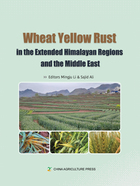
Chapter 1 Wheat Yellow Rust in China-Current Status and Future Perspectives
Mingju Li Yunnan Key Laboratory of Green Prevention and Control of Agricultural Transboundary Pests, Agricultural Environment and Resources Institute, Yunnan Academy of Agricultural Sciences, Kunming 650205, China Corresponding author: lily69618@163.com
Haoxing Li State Key Laboratory of Agricultural Microbiology, College of Life Science and Technology, Huazhong Agricultural University, Wuhan 430070, China
Chi He Yunnan Key Laboratory of Green Prevention and Control of Agricultural Transboundary Pests, Agricultural Environment and Resources Institute, Yunnan Academy of Agricultural Sciences, Kunming 650205, China
Abstract: Yellow (stripe) rust, caused by Puccinia striiformis f. sp. tritici, is considered to be the current most important crop disease in China. Comprehensive research on yellow rust has been carried out among a nationwide network of colleagues working for more than six decades. This review summarized the current knowledge of the epidemiology of wheat yellow rust, including over-summering, over-wintering, inter-regional dispersal of inoculum, resistance gene characterization, utilization and resistance mechanisms, race monitoring and population genetics of the pathogen, pathogenicity mechanisms and effector proteome. The information would be useful to propose a sustainable control strategy in China which mainly base on the use of resistance cultivars, supplemented by ecological regulation and accurate chemicals control.
Keywords: Wheat Yellow (Stripe) Rust;Puccinia striiformis f. sp. tritici;Yr Gene;Physiological Race;China